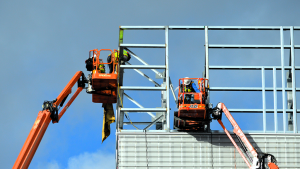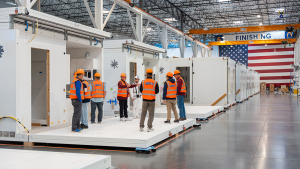Attendees at this year’s CanaData construction forecasts conference in Toronto were given a glimpse into what is happening in the Canadian and U.S. economies and how the tech sector is growing north of the border.
Alex Carrick, chief economist, ConstructConnect, shared some yellow flags concerning the U.S. economy.
“The U.S. economy has been surging ahead for 10 years and it’s starting to look like maybe things are going to be coming to an end and there are quite a few signs,” Carrick told delegates. “One of them is the fact that stock market indices have been moving sideways for at least a year.”
The estimated federal deficit for the current fiscal year, compounded by the corporate tax cut, will reach $1 trillion and Washington’s total debt is $22 trillion and climbing, said Carrick, adding interest rates are at historic lows.
“This deficit problem is going to come roaring back and when interest rates do eventually increase a lot of people are going to have trouble paying back this debt,” Carrick noted.
Another warning sign relates to interest rates and a phenomenon known as an inverted yield curve, which occurs when short-term interest rates rise above long-term interest rates, Carrick explained. The U.S. yield curve has either been close to or has exhibited inversion throughout most of 2019. In the past, this has almost always foreshadowed a recession, he noted.
Another yellow flag is manufacturing in contraction. Carrick said a gradually increasing number of construction jobs in Canada is catching up with a diminishing number of manufacturing jobs, which may not be a positive thing.
“Manufacturing activity levels don’t completely depend on employment anymore, that’s not necessarily a true gauge of how much activity there is because manufacturing has embraced automation, and construction — all indications say it has not embraced automation to the same degree,” said Carrick.
Canada’s secret economic weapon is population growth.
“The more people there are, provided they’ve got decent jobs, the more spending that takes place and Canada is in a juggernaut in terms of population growth,” Carrick stated. “In nominal terms, Canada’s population is increasing by more than half a million a year (1.4 per cent) and that means by 2024 our population will reach 40 million people and that leads to construction.”
When it comes to the outlook for the residential sector, Peter Norman, vice president and chief economist, Altus Group, said a growing preponderance of risk is a big factor.
“There are a lot of contrasting factors right now and risk, particularly big economic risk, is on the minds of consumers and it is an issue which has been affecting the housing market for the last 18 months or so and a lot of that is coming from the international environment,” said Norman, citing examples such as Brexit and the trade tensions between the U.S. and China.
Canada seems to be doing well in terms of job growth with close to half a million net new jobs since a year ago, especially in urban centres like Toronto. Job growth and the population growth that goes with it presents opportunities and challenges.
“That is both a boost for our potential ability to grow this region and grow the need for housing but it is also a big risk,” said Norman. “The first risk is how do we accommodate all of the population that comes with those jobs and the second risk is how secure are those jobs in the long run as Toronto, in particular, becomes more and more of a branch of those big U.S. companies.”
Kruti Desai, national research insight manager, data solutions, Altus Group, discussed the forecast for the commercial real estate sector and how Canada’s tech sector is continuing to grow.
“Seven of North America’s top 40 startup incubators and accelerators are in Canada,” explained Desai. “This makes Canada very competitive globally and places like Toronto, Waterloo and Vancouver are seeing the most growth for tech innovation…Tech companies are securing large amounts of space to accommodate things like their research facilities, innovation centres and incubators.”
In his presentation Carrick also touched on how many Canadians are securing tech jobs, though most tech companies are based in the U.S.
“The nature of construction is changing because if you’re building office space that’s going to house high tech companies they have different requirements and developers have to be aware of that,” said Carrick.
Desai said there is more of a need for flexible office space and shorter lease terms. The kinds of amenities being offered are also becoming a key factor.
“The common theme now in office, retail and residential is that it’s not just about the space, it’s about the services being offered,” explained Desai. “Amenities such as ping pong tables, bike racks, coffee bars, rooftop patios, they are trying to add these to their buildings and these added services are now becoming the standard.”
“In some cases, it means older offices will become vacant so investors are now considering upgrades to building systems and adding newer amenities to stay competitive.”
Follow Angela Gismondi on Twitter @DCN_Angela.











Recent Comments
comments for this post are closed